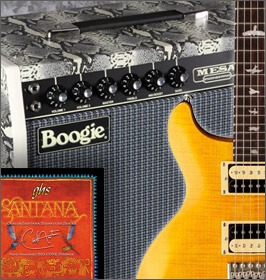By the late ’70s, Carlos Santana had met Paul Reed Smith and begun using one of the original PRS guitars. It wasn’t until about 20 years later, however, that the two teamed up to design, build and sell the PRS Santana model guitars.
20 Years to Create the Santana Signature guitar?
Why did it take so long? One reason may have been that Carlos had no way of knowing that he’d be playing these guitars for over four decades, with no end in sight. Also, once he and Paul Reed Smith had made the decision to create a signature Santana model, it could have taken a very long time to lock in all the specs.
High-profile artists are generally very careful when attaching their names to products, and their exacting wishes must be balanced with instruments that can be reasonably built and afforded by other players.
PRS Santana Signature Models Are Born
However the process began, it culminated in the mid ’90s, with the guitar originally called simply the Paul Reed Smith Santana Signature guitar. Eventually, in order to distinguish it from later models, it became known as the PRS Santana I model.
Unlike the Yamaha guitars that he had previously endorsed, however, the PRS Santana models that have been Carlos’ main axes for decades have changed over the years. It’s understandable, however, that as new models are introduced (and played by Santana), many of the features remain consistent.
Understanding the Categories
PRS Santana Signature guitars pretty much fall into three categories: the “main” models, the “less expensive” models, and the “limited edition” models. The “main” models are taken from exactly what Santana plays, and he may even use stock models on stage and in the studio. As he desires adapted features, or material requirements at the manufacturers change, these will be modified over time, thus giving rise to the history: Santana I, Santana II, Santana III, Santana MD, and most recently, the 25th Anniversary Santana models.
But since these models naturally fall into higher price points ($3,500 to $8,000), Paul Reed Smith eventually introduced budget priced models, the Santana SE and the Santana SE II (“SE” is most likely short for “Standard Edition”), as well as the latest: the Carlos Santana SE One Abraxas. While maintaining much of the look and feel, these guitars avoid the higher priced materials and handwork, thus selling for less than half the amount of the “main” models.
Finally there are “limited edition” models, including the Santana Brazilian. These would include rare and hard to find materials, as well as even more handwork. Since there is less information available about these models, they are not included in the PRS Santana Guitar Chart.
Santana PRS Guitar Features
Except for the SE models, all PRS Santana Guitars have many common features, 24 frets being one of them. When combined with the double-cutaway body style that Carlos favors, 24 frets allows him to play a high “E” without bending, which is handy for two of his (and many other guitarists’) favorite keys: “E” and “A.” And the 24.5″ scale length is close enough to Gibson’s scale length (“25”) that he’s used to it, from years of playing Gibson SG and Les Paul guitars.
Note: Undoubtedly one of the qualities that attracted Carlos to PRS guitars is their ability to provide some of the fat tone of a Gibson Les Paul, without the Les Paul’s spine-crushing weight.
In addition, all the bodies are Mahogany, and include some hollow chambers, in order to promote a full-bodied sound and extended sustain. (To reduce feeback, the chambers are not open, as they would be, for instance, on a Gibson 335 model). Except the SE models, the guitars also have “flamed” maple tops; the “flaming” indicates tight, beautiful circular grain patterns that are especially striking.
Curiously, all PRS Santana Signature models include different models of tremolos, which is interesting, considering that Carlos rarely uses a tremolo when playing. They may have been added to make the guitars more useful to a wider variety of players, and in case Carlos ever did need them. Other than the SE models, all the guitars wisely pair the tremolos with a set of locking tuners.
Paul Reed Smith Electronics
True to Santana’s preferences, all models have two humbucking pickups, although they have been “tweaked” over the years. The controls are simple: a volume control, a tone control, and a 3-way toggle pickup selector (except the original Santana I model, which had 2 mini switches).
The most recent model — Santana MD — also offers the “Master Voice Control,” which is an active tone circuit that functions as a coil splitter or “voice alterer.” The idea is to access a single-coil sound (probably more in line with Santana’s original pickups from the ’60s than a Fender style single-coil) with the flick of a switch.
Comparison of PRS Santana Model Features
The PRS Santana Model Chart is comprised of information available (much gleaned from the actual Paul Reed Smith web site) about each model — including specifications, and the years they were in production. Currently, the only model PRS still offers is the Santana MD guitar, though the others are available as used instruments.
Please feel free to contact the Webmaster with any additions or edits:


